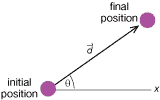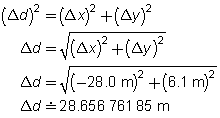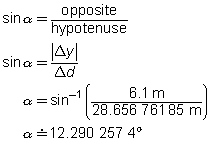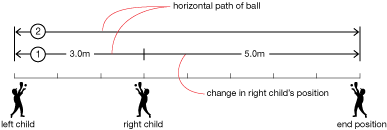Module 1—Motion

Figure 2
Displacement is a vector quantity whose magnitude (length) is equal to the straight-line distance from the initial position to the final position. The length of the arrow shown in Figure 2 represents the magnitude of the displacement vector. The direction of the displacement vector coincides with the direction from the initial to the final position. The direction of the displacement vector shown in Figure 2 is measured by the angle, θ, between the arrow and the direction of the positive x-axis.
The symbol for displacement to be used in Physics 20 is ![]() (the simulation uses
(the simulation uses ![]() so be careful). When writing the symbol by hand, include the Greek letter delta and the vector notation (a triangle in front and an arrow over the letter d).
so be careful). When writing the symbol by hand, include the Greek letter delta and the vector notation (a triangle in front and an arrow over the letter d).
Calculating Displacement
Displacement is calculated using the initial and final positions of the object.
Example Problem
An object that is initially at position (x, y)i = (10.0, –15.0) m moves to a final position of (x, y)f = (–18.0, –8.9) m. Calculate the object’s displacement.
Solution
Start by drawing a diagram with all relevant quantities, as illustrated in Figure 3.

Figure 3
 (1)
(1)
The displacement vector has an x component (displacement along the x-axis) equal to the change in the x position.
 (2)
(2)
The displacement vector also has a y component (displacement along the y-axis) equal to the change in the y position.
 (3)
(3)
The triangle formed by these two components and the resultant vector is a right triangle; therefore, the Pythagorean theorem (c2 = a2 + b2) can be applied to find the magnitude of the displacement.
 (4)
(4)To calculate the direction of the displacement relative to the positive x-axis, first calculate its complement, α (see Figure 3).
 (5)
(5)Finally, using Figure 3, determine how to calculate θ.
Note: When calculating a displacement, it is not sufficient to calculate only the magnitude, as in result (3). Displacement is a vector, and its magnitude is not the entire story. A vector’s direction is just as important. Thus, only results (3) and (5) together provide a complete description for the total displacement.
 (6)
(6)
LAB 3. Calculate the displacement (magnitude and direction) of the ball based on the following instructions:
-
Reset (
 ) the simulation, and turn on the gridlines (
) the simulation, and turn on the gridlines ( ).
).
-
Position (
 ) the ball at (x, y)i = (10.0, –10.0) m.
) the ball at (x, y)i = (10.0, –10.0) m.
-
Drag the ball along any curved path to somewhere near (x, y)f = (–18.0, –10.0) m.
Show your work, and use the simulation to verify that the answer you calculated is correct.
 Module 1: Lesson 2 Assignment
Module 1: Lesson 2 Assignment
Remember to submit the answer to LAB 4 to your teacher as part of your Module 1: Lesson 2 Assignment.
LAB 4. Calculate the displacement (magnitude and direction) of the ball when it is moved from the initial to the final position.
-
initial position (x, y)i = (–10.0, 10.0) m
-
final position (x, y)f = (15.0, –10.0) m
Show your work, and use the simulation to verify that the answer you calculated is correct.
Problem 2
Can the distance travelled ever be less than the magnitude of the displacement?

The distance travelled by the ball is defined as the length of the actual path travelled by the ball. If you place a string on the blue path and measure its length, you will determine the distance travelled by the ball. Distance travelled is denoted by the symbol Δd.
Procedure
-
Reset (
 ) the simulation.
) the simulation. -
Turn on the gridlines (
 ).
). -
Drag the ball to various positions on the simulation, and compare the distance travelled (Δd) with the magnitude of the displacement (
 ).
).
Observations
LAB 5. Record your observations by completing the following table.
| Trial 1 | Trial 2 | Trial 3 |
|---|---|---|
distance (Δd): _______m
displacement ( ________ m |
distance (Δd): _______m
displacement ( |
distance (Δd): _______m
displacement ( |
Analysis
 Module 1: Lesson 2 Assignment
Module 1: Lesson 2 Assignment
Remember to submit the answer to LAB 6 to your teacher as part of your Module 1: Lesson 2 Assignment.
LAB 6. In general, the distance travelled will be __________ than the magnitude of the displacement. The two will be equal only when the path taken is a ____________ line and when the path is traversed in a single direction (no backtracking).
Distance travelled, like the distance between two points, is a scalar quantity—in contrast to displacement, which is a vector quantity.
 Self-Check
Self-Check
SC 3. Explain the difference between the scalar quantity distance and the vector quantity displacement, and give the proper symbol for each.
 Self-Check Answer
Self-Check Answer
SC 3. Distance is the length of the path needed to go from one place to another. It has no direction attached. The symbol for distance is Δd. Displacement is a measure of the magnitude of a change in position, and it includes an expression of direction. The symbol for displacement is ![]() .
.
Lab Summary
How is the more familiar scalar quantity distance different than the vector quantity displacement?
Distance travelled is a measure of how far an object has moved. Displacement is a measure of the magnitude of a change in position, and it includes an expression of direction.
 Read
Read
Review pages 6 to 10 of your textbook, and look particularly at the symbols for distance, position, and displacement. Also, notice how plus and minus signs are used to indicate direction in one dimension.
 Self-Check
Self-Check
SC 4. On page 10 of your textbook, complete question 3 of “1.1 Check and Reflect.”
SC 5. On page 10 of your textbook, complete question 4 of “1.1 Check and Reflect.”
SC 6. On page 10 of your textbook, complete question 6 of “1.1 Check and Reflect.”
 Self-Check Answers
Self-Check Answers
SC 4. A reference point is necessary for measurements such as position, distance, and displacement because they are all measured relative to some reference point.
SC 5.
4. (a)–(d)

Analysis and Solution
4. (e) The reference point is Greg. Let to the right be positive direction.
![]()
Paraphrase
The displacement of the teacher is 13.0 m [right].
SC 6.

Required
- the horizontal distance the ball travels (Δd)
- the displacement of the ball (
 )
)
Analysis and Solution
Let the right be the positive direction. In calculating distance, direction is not taken into account. However, in calculating displacement, it is.

Paraphrase
The horizontal distance the ball travels is 11.0 m.
The displacement of the ball is 5.0 m [right] of its initial position.
 Try This
Try This
TR 1. Complete “2-2 QuickLab: Vector Walk” on page 79 of your textbook. This activity should be completed with a partner. If it is impossible to do the activity outdoors, the following adaptations are acceptable:
-
Choose an indoor floor, and reduce the distances by a factor of 10 (e.g., a = 0.50 m).
-
Choose 1-cm ruled graph paper, and reduce the distances by a factor of 100 (e.g., a = 5.0 cm).
Answer questions 1, 2, and 3 on page 79 of your textbook.